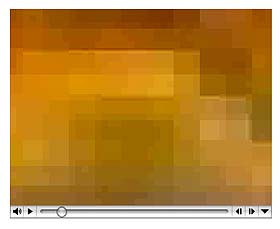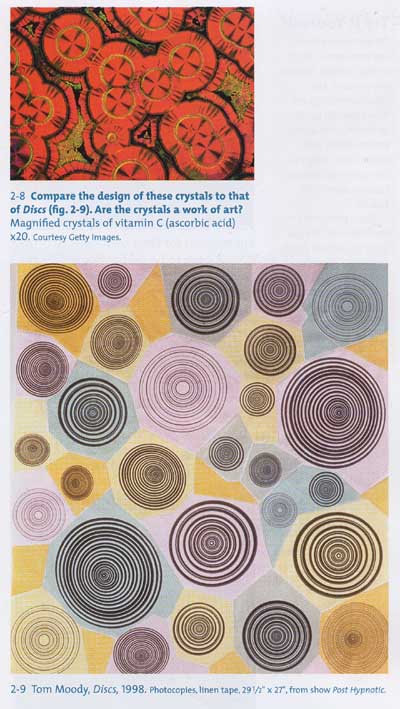View current page
...more recent posts
The 3rd edition of The Visual Experience, a secondary school text by Jack Hobbs, Richard Salome, and Ken Vieth, includes a piece of mine, Discs. It's on p. 15, in a section called The Philosophy of Art:
The authors gave me a break in not asking the thornier, implied question: "If the crystals aren't a work of art, why is Discs?" Fortunately the text covers that elsewhere, explaining the history of abstraction, found objects, etc. (The scan is blurry because every way I tried to sharpen it or tweak the contrast it distorted the piece(s).)
Artist Sally McKay is participating in a show in Toronto, opening April 30, called "Robot Landscapes." In her piece, a small mirror-lined box serves as home to a solar powered robot slowly caroming around inside. Reflected on the inner walls of the box is a continuously looped video of a half-factual, half demented Martian landscape; a kind of Zen foil-ball garden with a dozing, skullfaced inhabitant, who may or may not be inflicting intermittent, flaring image breakdown on the Rover's prying digital eyes. The mirror-diorama is viewed through a window, with nearby headphones chiming musical accompaniment--a kind of lo fi, ambio-melodic soundscape created by yours truly. Sally explains more of the particulars here, and she's also offering a scaled-down version of the 9 inch wide video as a streaming or downloadable online video. A borrowed copy of the interface is below.

click for streaming video
(or option click / right click here for download)
graphics by Sally McKay, music by Tom Moody
Saturday night, April 24, a group of laptop performers convened at vertexList, a newish space in the old Four Walls location in Brooklyn. Video artists picked audio artists as collaborators (and vice versa) and the work seemed as random as the pairings: synergy was only intermittently achieved. The video part of the Jeremy Bernstein/Glomag collaboration (coruscating patterns of finely minced abstraction) showed more subtlety than the clunky audio, and the audio part of the jenghizkhan*/Daniel Vatsky union (mysterious, sexily-filtered ambient industrial keyboards) eclipsed the video's rather generic typography-cum-50s-science-textbook imagery. One moment where everything clicked came during the token "analog segment," when Mike Ballou's super-8 film of a crowd pulling a giant helium-inflated pig through the sky found suitable porcine accompaniment in Brian Dewan's morose vacuum tubular oinks.
A cranky comment: some artbloggers outside NY have said "there's nothing going on here" or words to that effect. That's clearly wrong. The scene is so rich, so multi-layered, so overflowing with good work that gallerygoers have become blase--talking, schmoozing, laughing, flirting, and exchanging business cards during performances. The music and video serve only as a cool clublike backdrop for their networking. This is Williamsburg, after all, where those art school "how to survive as an artist" courses are field-tested en masse. To put it bluntly, the pigs weren't just up there on the screen Saturday.
*aka John Parker
CLASSIC RAVE HITS! (except I don't know what any of them are)
All of the following house and breakbeat rave techno tracks were taped off the radio in '93 and '94, specifically during DJ Jeff K's live mix show, "Edge Club," on KDGE-FM in Dallas (besides killing Kennedy, that city has been a haven for club music since the late '80s, as Simon Reynolds noted in his book Generation E). I made them as "studio tapes" (i.e. to play as background music while working on paintings in my studio), but found them indispensable when I moved to NY shortly thereafter and had all my other music in storage. Some tracks were played by Jeff K himself, others by the guest DJs he had on each week (DJ Icy, the Hardkiss collective, Utah Saints (!)). What they all have in common is (1) I still play them on my battered cassettes and (2) I don't know any of the artists or titles, except as noted below. Now that they've been extracted from the longer mixes where they originally appeared--digitally clipped, sutured, & faded in or out as .mp3s--a little attribution help would be greatly appreciated: any information you might have about this weird, E'd-up, often gemlike music.
Techno-Rave
Track 1 [4.5 MB]. "Like this," "come down," and an uncanny "blablablablablablablablablah" are the samples punctuating this frenetic Two Bad Mice-like track. [Update, 2013: finally identified one -- this is a variation of Krome & Time's "Manic Stampede"]
Track 2 [3.4 MB]. The insipid "different strokes for different folks" vocal commencing this number is soon belied by Mentasm stabs and other craziness. The ending sample of a lad saying "only originate and never pirate" (as in "pyrate") cropped up a lot around this time. [Update, June 2021 -- Isotonik - "Different Strokes" (1992) -- hat tip to dj buttstuf on IRC.]
Track 3 [3.7 MB]. Very minimal breakbeat rave recorded on Jeff K's birthday. A sequence of 12 notes is repeated (with the filtering constantly changing) until the middle, when it is replaced by another sequence of 12 notes. [Update, June 2021 -- Psychotropic - "Psychosis" (1990) -- hat tip to dj buttstuf on IRC.]
Track 4 [4 MB]. From a live mix at the Bomb Factory in Deep Ellum, this peppy number (possibly by a Texas producer) merges flawlessly into Joey Beltram's famous "Energy Flash," right before the fade.
House
Track 5 [4.1 MB]. A bouncy little march opens and closes this Dixieland-inflected track. [Update, June 2021 -- L'il Louis - "I'm Hot for You" (Rhythm Method Tribal Mix (1994) -- hat tip to dj buttstuf on IRC.]
Track 6 [5 MB]. Disco-era drum pads, a Chinese prepared piano hook, and a vaguely Middle Eastern diva wail: it's catchier than that sounds.
Track 7 [5.5 MB]. Digs and Woosh of the UK's legendary DIY Crew guest-mixed this deep house track. James at Satellite (who met the DIY-ers in Dallas) thought it was from Chicago, maybe Balance Recordings. The string riff magically smeared dozens of ways sounds like turntablism but I assume it's the sampler. [Update, June 2021 -- Last Session (Ron Trent & Chez Damier) "Sometimes I Feel Like" (Chicago Vox Mix) (1994 -- Blue Cucaracha label) -- hat tip to dj buttstuf on IRC.]
Track 8 [5 MB]. Spare (as in lean) organ riffs from guest DJ Germ-E's mix.
BONUS: Downtempo Rave (?)
Track 9 (5.5 MB). Not sure what else to call this; it's too giddy to be considered triphop. It's from a mix by guest DJ Kid E. [Update, June 2021 -- "Melt City" by Overmow (1992) -- hat tip to dj buttstuf on IRC.]
Animations from the Internet Raytracing Competition are below (each .mpg is around 5MB). How POV Raytracing differs from the stuff Pixar does, or things made with 3D rendering software like Poser or Bryce, I'm not entirely sure. The main feature seems to be how light rays reflect and refract off/through various materials and surfaces, and the folks who make these things are as nerdy as car body fetishists about their various glints and sheens. As for subject matter, the Whitney curators' "quest for the adolescent" could have started and ended here. ("Uh, we meant, a different kind of adolescent...") To cull the rather minimalistic samples below required wading through dozens of one-act plays about muscly aliens and "trips through the wormhole" populated by characters that look like Woody and Buzz. But these are good. The fact that they were done by individuals as opposed to corporate teams weighs heavily in favor of them as a nascent, internet-spawned art form.
Digital Mousetrap Game (the only one with [so-so] sound; the rest are silent)
The End of the Cape Hatteras Lighthouse

Photo by Justine Kurland, from "The Secret World of Girls" ("perhaps the most profound photographic series of this or any other century" --J. Saltz)
Just kidding, the actual attribution is "LiveJournal - artist unknown." Kevin has a good suggested caption in the comments to this post: "Take Your Daughter to Work Day is taken to a tragic but hilarious extreme."
Church of Lo Fi
A friend just jokingly referred to my preference for old computer programs over current software as my "religion." No, religion is believing you have to buy the newest program to make the best art. The opposite of that is...iconoclasm?
But idol-smashing can be dogmatic, too, so maybe it's better to couch the discussion in terms of "desired artistic effects." My old dying Mac SE makes cool sounds from the clipping and distortion that comes from "overdriving" the machine's limited synths, just in normal use--rhythmic patterns of clicks, ominous atmospheric rumbles... You won't get that with garageband (or maybe there's a pallette called "old Mac flaws"? I don't really want to hear about it). Also, there's something about working against limitations, as opposed to having a machine that "does it all for you." Think movie special effects on a budget vs profligate CGI. And finally, there's a certain exoticism of hearing/seeing old tools as they were before years of "improvements." Some of those improvements are engineering tweaks (for speed, etc) but others are simple value judgments the user had no input in. As Dan Graham once said--in so many words, and not necessarily for this reason--the "recently outmoded" can be one of the more fertile and radical places for artists to work.
Anyway, if lo fi is a religion, here's a chapter of the Bible, written by painter Alexander Ross for the "Static" show co-organized by John Pomara and me in '98 (I especially like the bolded para.):
The Recent History of Static in Recorded Music
by Alexander Ross
The static trend in rock music grew initially out of the fuzz guitar sound (best known from the Rolling Stones' "[I Can't Get No] Satisfaction"), which imitated an over-driven or distorting amplifier. Hard-rock outfits continued to push the "guitar wall of sound" well after the '60s, refining it into a subtle and controlled art.
The creative fringe took interest in an accidental by-product of this distortion: the overtones of fuzz, a warm "pink noise" (white noise is static without tone, pink noise is static or "snow" with a hum, or discernible pitch) that rode seemingly independently on top of the music. An early exploration of this might be Eno's "Needle in the Camel's Eye" from 1973, where the constant smashing of guitar chords creates a wall of wavering noise above the song.
A foundational work appeared in the mid-'70s with Lou Reed's controversial and fan-disappointing double LP Metal Machine Music, an all-static-and-feedback statement that figures in rock history much the way Futurist noise performances function in the history of theatre: pure, unequivocal rebellion.
There were some notable static undergrounds coming along in the late '70s/early 80's, namely Chrome (out of San Francisco), and a little later Fi (pronounced "eff eye"). Throbbing Gristle might also be mentioned here, as well as This Heat and Cabaret Voltaire (for example, "No Escape" off their classic first release, Mix-Up). The first group to make the intentional breakthrough into pure static would have to be The Jesus & Mary Chain, who eq-ed the bass-end off the fuzz chords entirely, leaving a shrill, static constant running relentlessly throughout their songs. Next would be Kevin Shields of My Bloody Valentine, where the static becomes more textured and smeared, literally permeating the music. The effect is a sexy, dreamlike blur echoing early '90s trends in fashion photography. Static finally becomes the main subject with the rise of Flying Saucer Attack (Chorus is a good example), out of Virginia, of all places. Here the static is totally frontal, and the music sort of whispers at you through a snowy haze.
The advent of the compact disc in all its sterile flawlessness brought about the realization that technological defects such as tape hiss, amp buzz, record groove ticks, and ultimately the computerized glitches sometimes heard on the CD itself were now interesting sounds never before utilized in conjunction with music. This, combined with the inexpensive home recording boom, coalesced into what became known as LO-FI. Major players, largely confined to the US and New Zealand, include Lou Barlow/Sentridoh, Daniel Johnston, Guided By Voices, and (from New Zealand) post-rockers The Dead C and This Kind of Punishment.
Mid-'90s developments quickly cross-over into the techno-ambient realms with Oval, who boldly dominate the glitch and hiss scene. Mention should be made of Scanner, an individual who scans cell phone conversations and create pieces out of them, with the natural static of the transmission wavering in and out. Most recently is Porter Ricks, also techno-ambient, whose distant discotheque is heard pleasantly through walls of dreamy smush.
The ambient/industrial sector was long-ago onto the static phenomenon, but here there is no music at all, just pure, wonderful noise. Examples here would be The Hafler Trio, Arcane Device, Tibetan Red, PBK, and early Nocturnal Emissions.
Downloadin on the beach or downloadin from TV
Two or a billion sharers, it means nothin to she
Teenagers and grannies is who she likes to do
But then I'm sure you know she's comin' after you.
Her name is R1AA and she sues you for The Man
Just like a river twistin' through a clickin' land...
And when she sues you she does it 'cause she can
Oh R1AA R1AA suin' for The Man.

